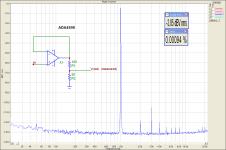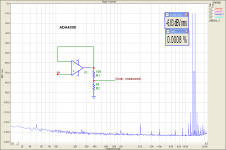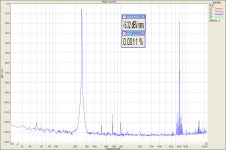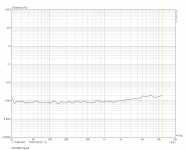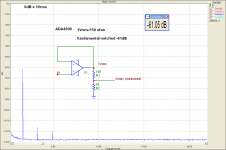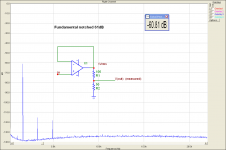Karl, what was the signal amplitude.
Hi Pavel, the test tones were at 0db from a Denon test CD.
I have found the same sort of measurement with other IC's, so it is consistent with prediction.
You might like to try better IC's
Just a brief measurement of loaded ADA4898 (100 ohm + 50 ohm), schematics is in the plot. Please compare with Mooly's 4562 (and do not forget to read Y axis).
Attachments
Last edited:
Any comments? You guys just have to make a choice of the part that fits to your application, not to overload the improper (unsuitable) part above its limits. As far as I remember I have recommended the ADA4898 at least 5 - 10 time here - without anyone interested.
Attachments
Now that is unfair, PMA. People use what they have or what is available at the time of design. The AD part looks good, but I have never seen one, even as a sample. OPPO uses the 4562 extensively, as well as many other high end designers. Let's start here first. It is more widely used.
Now that is unfair, PMA.
Yeah. Imagine that, choosing an appropriate part for a specified task. Crazy! Unfair! Horrible!
You should indeed be terribly offended at Pavel's use of actual engineering.
Now that is unfair, PMA.
Really? And you are saying that? Look, my comment was addressed rather to professionals who are not able to make a choice of the right part. This ADA has been available since 2008/2009. You just have to be flexible, permanently. Do not live in the past.
Now that is unfair, PMA. People use what they have or what is available at the time of design. The AD part looks good, but I have never seen one, even as a sample. OPPO uses the 4562 extensively, as well as many other high end designers. Let's start here first. It is more widely used.
Jesus, John, that's plain ridiculous. Here we are, asking an op amp to do what it's not designed to do, and then we add insult to injury by using whatever happens to be at hand?
What if the nearest thing they have is a 741?
I would have thought the very first thing anyone starting out in DIY should learn is how to select parts for their role in the whole circuit, not grab what's nearest to them.
Or use it just because it's popular. The King of popularity is the 741.
Output current of LM4562 is up to +/- 26mA. With 100 ohm load and CD drive, which is usually +/-3V, the LM4562 is asked to give +/-30mA output current. It is above its specs, no wonder it starts to distort.
AD4898 output current is up to +/-56mA (40mA rms). LM6171 up to +/-90mA.
AD4898 output current is up to +/-56mA (40mA rms). LM6171 up to +/-90mA.
Last edited:
Now that is unfair, PMA. People use what they have or what is available at the time of design. The AD part looks good, but I have never seen one, even as a sample. OPPO uses the 4562 extensively, as well as many other high end designers. Let's start here first. It is more widely used.
I have used 10 pairs of them in parallel in my low noise amplifier for measurements (0.1Hz - 1MHz, 220pV/sqrtHz)
and quite a few left over for some amplifiers more, so if you cannot use digikey
< Linear - Amplifiers - Instrumentation, OP Amps, Buffer Amps | Integrierte Schaltungen (ICs) | DigiKey >
for whatever reason, I would be willing to send you a few.
regards, Gerhard
Last edited:
Can't someone set up a streaming webserver that runs a script to play files randomly and takes descriptions from listeners? I think this would be make it so everyone is taking the same test with the same protocol.
Heck, it could even be a blog. Like an interactive blog with new tests every week or so. I think that would be genuinely positive for the audio community.
Heck, it could even be a blog. Like an interactive blog with new tests every week or so. I think that would be genuinely positive for the audio community.
for whatever reason, I would be willing to send you a few.
John has to be kidding he knows that he only needs to ask and I would send him anything he wants as I have to SY, Jan, Samuel and others.
Yeah. Imagine that, choosing an appropriate part for a specified task. Crazy! Unfair! Horrible!
You should indeed be terribly offended at Pavel's use of actual engineering.
SY, your replies are hilarious!

They're partly what keeps me following this thread.
I find it amusing that Mr. Curl hasn't heard of the ADA4898-1/2 before. A simple Google search will turn up many good op-amps that apparently "aren't fair" because OPPO Digital and other designers don't use them.
Since he hasn't named any of the op-amps he prefers, I'm going to assume that they're run-of-the-mill devices that other designer prefer as well.
You will Scott? Thank you. IT has been perhaps almost a decade since I got parts from you. Now, can I fit these parts in a test socket?
Someone here can help you with adapters I'm sure.
He did say 200kHz so being generous and say you only look at the first two harmonics that's a 600kHz noise BW. -140dB at 7V rms in 600kHz is about .9nV/rt-Hz so now the real part of the impedance of all the frequency generating components must be <50 Ohms. For fixed frequency oscillators I think only Baxendall's passive L/C post filtering could do this though I shudder to think of doing it at 50 Ohm's
Thanks... it then seems within the realm of possibility. David just stated his needs - specs - in the Equip & Tools/Low Distortion Audio range Osc/lines #4053 and 4058.
-RNMarsh
I have used 10 pairs of them in parallel in my low noise amplifier for measurements (0.1Hz - 1MHz, 220pV/sqrtHz)
regards, Gerhard
And FFT/harmonics of the 10 parallel amps into 50/100 Ohms is ______ ?
-RNM
A comparable part that I do use is the LME49990 for the front end of the JC-3 phono stage. I could have used the AD797, but I found it too expensive when other parts of the same quality were available.
I have designed 2 audio products with the AD825. I like that part a lot. The ADA4898-1 looks good, but the design is in production and I don't see any advantage in changing to it.
I have designed 2 audio products with the AD825. I like that part a lot. The ADA4898-1 looks good, but the design is in production and I don't see any advantage in changing to it.
Just a brief measurement of loaded ADA4898 (100 ohm + 50 ohm), schematics is in the plot.
The measurement that I have shown yesterday was to illustrate that we have a choice of some opamps that are able to drive difficult loads. But it was affected by the resolution of the direct method.
Today, I would like to show a measurement of ADA4898, loaded with 150 ohm, at 1Vrms, with a notch filter and different HW. I am able to measure much lower distortion then. As you can see, behaviour of ADA4898 at 1Vrms/150 ohm is perfect. Unfortunately, I cannot get more amplitude from this method.
Correction to filter frequency response is to be done, so 2H result is in fact 11dB worse and 3H result is 6dB worse. Even so it is perfect.
Why my choice was ADA4898, about 4 years ago:
Ultralow noise 0.9 nV/√Hz, 2.4 pA/√Hz, 1.2 nV/√Hz @ 10 Hz
Wide supply voltage range: ±5 V to ±16 V
High speed −3 dB bandwidth: 65 MHz (G = +1)
Slew rate: 55 V/μs
Unity gain stable
Low input offset voltage: 150 μV maximum
Low input offset voltage drift: 1 μV/°C
Low input bias current: −0.1 μA
Low input bias current drift: 2 nA/°C
Supply current: 8 mA
Many opamps may be googled, but not many with such low noise, high speed, low distortion and high output drive capability - and perfect sound.
Good job, AD engineers.
Edit: I am adding one at beter Y resolution, same conditions.
Attachments
Last edited:
Any comments? You guys just have to make a choice of the part that fits to your application, not to overload the improper (unsuitable) part above its limits. As far as I remember I have recommended the ADA4898 at least 5 - 10 time here - without anyone interested.
It is a fantastic IC but IIRC it's only available in SOIC - that's why I ended up going with the AD797 for my new preamp.
The ADA4898 is about 1 dB quieter than the 797 as well in the 700 to 2.5 k Ohm source resistance range.
- Status
- Not open for further replies.
- Home
- Member Areas
- The Lounge
- John Curl's Blowtorch preamplifier part II
